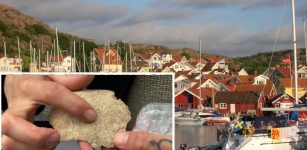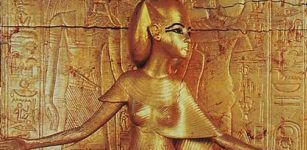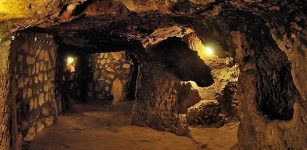Mysterious Object In Asuka – The Place Of ‘Flying Birds’
A. Sutherland - AncientPages.com - Asuka, which means in Ainu, "flying birds" is one of the most historically rich places in Japan.
This remarkable small village, located approximately 20 kilometers south of Nara City, in the Kansai region of Honshu, central Japan, is covered with unusually shaped megaliths, of which many are of titanic dimensions and weights.
So far, no one has been able to shed light on the past of Asuka's stone relics and monuments and their hidden history. They are shrouded in mystery relative to their date of construction and original function.
The most famous of the monuments is ship-like boulder "Masuda no iwafune", located near the top of a hill in the village, in a place Ishi-no-Ho-den".

The "boast stone" is one of most strikingly enigmatic of the Asuka megaliths. One puzzling characteristic is that in places it is rough and unfinished, seemingly entirely like a work of nature, and in other places beautifully cut into right-angled planes.."
"Masuda no Iwafune" does not resemble the style or construction of any other Buddhist monument and represents one of the greatest mysteries of Japan.
Masuda was the name of a lake thought to have been near this stone; hence the translation would literally be "Masuda ship rock".
For the first time, this gigantic boulder was mentioned in Japanese literature of the 8th century.

The so-called 'rock ship of Masuda' - Masuda-no-iwafune - drawing from P.F. von Siebold's volume 1 of his books NIPPON" (1832)"
However, it still represents one of the greatest archaeological puzzles of Japan, because no archaeologist is able to state with certainty how old the Masuda-no-wafune really is or what its original function might have been.
In one of our earlier articles, we wrote about some strange sightings recorded in the sacred texts of The Nihongi. For example in 634 A.D. "a long star seen in the south... which the people called a besom-star", and in 637 A.D. a large "star" was floating from East to West causing a thunder-like noise.
On the 7th day of the second month of Spring, 640 A.D. people saw a "star" that entered the Moon. and another "guest star" entered the Moon on the 9th July 642 A.D.
See also:
Probably The Oldest Star Map Discovered In Stone Chamber Of The Kitora Tomb, Asuka Nara, Japan
First Peoples Of Japan: Ainu Civilization And Its Unknown Origin
Was the Masuda-no-iwafune astronomically oriented? Was it a structure constructed for observations of the sky? A number of questions still remain relative to whether or not the stone was actually used for astronomical observation.
In its upper part, the "Masuda ship rock" has two holes, which were long concealed by pine trees.
The monument is 11 meters long, 8 meters wide and 4.7 meters high and weighs approximately 1000 tons. The upper surface is flat, with a shallow trough and two square holes.
At present, the stone bears lattice-shaped indentations around its base which testify to the process used in flattening the outer surfaces.
There have been countless attempts to explain its origin and purpose, but all these attempts have failed. Researchers have already investigated the rock with ultrasound devices and measured the object with laser scanners only to find nothing.
"The actual purpose" of the great megalith remains a mystery, according to the Asuka Historical Museum
Written by – A. Sutherland AncientPages.com Senior Staff Writer
Copyright © AncientPages.com All rights reserved. This material may not be published, broadcast, rewritten or redistributed in whole or part without the express written permission of AncientPages.com
More From Ancient Pages
-
 Arrow Pre-Dating The Vikings Discovered After Being Lost In The Ice For 1,500 Years
Archaeology | Aug 25, 2022
Arrow Pre-Dating The Vikings Discovered After Being Lost In The Ice For 1,500 Years
Archaeology | Aug 25, 2022 -
 Jack o’ Legs – The Kind Hertfordshire Giant Who Robbed The Rich And Gave To The Poor
Featured Stories | Sep 20, 2021
Jack o’ Legs – The Kind Hertfordshire Giant Who Robbed The Rich And Gave To The Poor
Featured Stories | Sep 20, 2021 -
 Man In Sweden Finds Viking Age Skeleton In His Garden
Archaeology | Jun 30, 2023
Man In Sweden Finds Viking Age Skeleton In His Garden
Archaeology | Jun 30, 2023 -
 ChatGPT Is Confronting, But Humans Have Always Adapted To New Technology – Ask The Mesopotamians, Who Invented Writing
Featured Stories | Feb 13, 2023
ChatGPT Is Confronting, But Humans Have Always Adapted To New Technology – Ask The Mesopotamians, Who Invented Writing
Featured Stories | Feb 13, 2023 -
 Amazing ‘Guennol Lioness’ – One Of The Greatest Ancient Works Of Art Of All Time
Artifacts | Sep 6, 2018
Amazing ‘Guennol Lioness’ – One Of The Greatest Ancient Works Of Art Of All Time
Artifacts | Sep 6, 2018 -
 Ancient Tradition And True Meaning Of Candy Canes
Ancient Traditions And Customs | Dec 24, 2015
Ancient Tradition And True Meaning Of Candy Canes
Ancient Traditions And Customs | Dec 24, 2015 -
 Can You Solve The Mystery Of The Nessglyph? Archaeologists Ask
Archaeology | Jan 31, 2023
Can You Solve The Mystery Of The Nessglyph? Archaeologists Ask
Archaeology | Jan 31, 2023 -
 New DNA Study Reveals How The Black Rat Colonized Europe In The Roman And Medieval Periods
Archaeology | May 6, 2022
New DNA Study Reveals How The Black Rat Colonized Europe In The Roman And Medieval Periods
Archaeology | May 6, 2022 -
 Oklahoma’s Mysterious Hollow Hill – The Unexpected – Part 2
Featured Stories | Jul 9, 2020
Oklahoma’s Mysterious Hollow Hill – The Unexpected – Part 2
Featured Stories | Jul 9, 2020 -
 Advanced Ancient Technology: Could Ancient Peruvians Soften Stone?
Ancient Technology | May 7, 2015
Advanced Ancient Technology: Could Ancient Peruvians Soften Stone?
Ancient Technology | May 7, 2015 -
 Mysterious Fossilized Antarctic Forest May Offer Evidence Of The Great Flood – But Some Facts Speak Against This Theory
Archaeology | Dec 27, 2017
Mysterious Fossilized Antarctic Forest May Offer Evidence Of The Great Flood – But Some Facts Speak Against This Theory
Archaeology | Dec 27, 2017 -
 Ice Age People Returned To Central Europe Much Earlier Than Previously Thought
Archaeology | Jul 3, 2024
Ice Age People Returned To Central Europe Much Earlier Than Previously Thought
Archaeology | Jul 3, 2024 -
 Serket: Scorpion Goddess Who Could Heal Poisonous Bites And Sting Evildoers
Egyptian Mythology | May 17, 2019
Serket: Scorpion Goddess Who Could Heal Poisonous Bites And Sting Evildoers
Egyptian Mythology | May 17, 2019 -
 Eriu: Powerful Irish Goddess And Sacred Uisneach Hill Where She And God Lugh Are Buried
Celtic Mythology | Feb 15, 2019
Eriu: Powerful Irish Goddess And Sacred Uisneach Hill Where She And God Lugh Are Buried
Celtic Mythology | Feb 15, 2019 -
 Excavations Reveal Massive Building And Invaluable Ceramics In Ancient City Of Poseidonia
Archaeology | Apr 10, 2017
Excavations Reveal Massive Building And Invaluable Ceramics In Ancient City Of Poseidonia
Archaeology | Apr 10, 2017 -
 Highly Sophisticated Underground City Of Derinkuyu – Who Were The Master Builders?
Featured Stories | Jul 22, 2014
Highly Sophisticated Underground City Of Derinkuyu – Who Were The Master Builders?
Featured Stories | Jul 22, 2014 -
 Secrets Of The Assyrian Dream Book And Dream Interpretation In The Ancient Near East
Featured Stories | Aug 6, 2021
Secrets Of The Assyrian Dream Book And Dream Interpretation In The Ancient Near East
Featured Stories | Aug 6, 2021 -
 Advanced Heating System Discovered In Ruins Of Metropolis ‘City Of Mother Goddess’
Archaeology | Nov 17, 2019
Advanced Heating System Discovered In Ruins Of Metropolis ‘City Of Mother Goddess’
Archaeology | Nov 17, 2019 -
 On This Day In History: Fatal Fire Broke Out In Tre Kronor “Three Crowns” Castle, Stockholm, Sweden – On May 7, 1697
News | Dec 7, 2021
On This Day In History: Fatal Fire Broke Out In Tre Kronor “Three Crowns” Castle, Stockholm, Sweden – On May 7, 1697
News | Dec 7, 2021 -
 Oldest Indo-European Calendar Based On The Orion Constellation Is Engraved On A Vucedol Vessel
Artifacts | Jun 7, 2021
Oldest Indo-European Calendar Based On The Orion Constellation Is Engraved On A Vucedol Vessel
Artifacts | Jun 7, 2021




